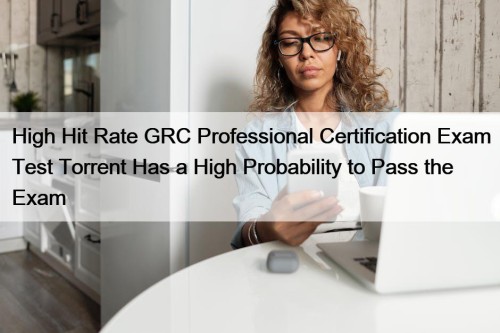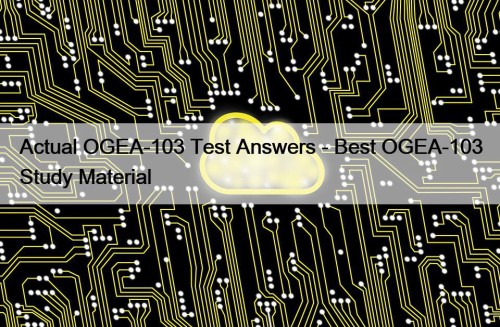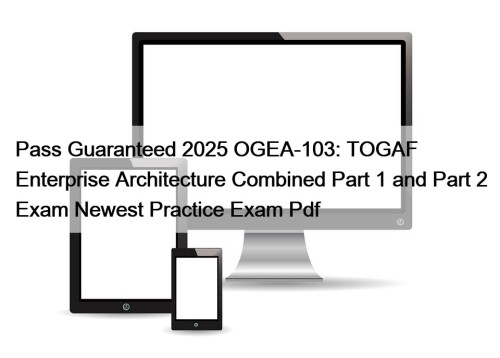Most Popular
 High Hit Rate GRC Professional Certification Exam Test Torrent Has a High Probability to Pass the Exam
High Hit Rate GRC Professional Certification Exam Test Torrent Has a High Probability to Pass the Exam
The high quality and high efficiency of GRCP study guide ...
 Actual OGEA-103 Test Answers - Best OGEA-103 Study Material
Actual OGEA-103 Test Answers - Best OGEA-103 Study Material
P.S. Free & New OGEA-103 dumps are available on Google ...
 Pass Guaranteed 2025 OGEA-103: TOGAF Enterprise Architecture Combined Part 1 and Part 2 Exam Newest Practice Exam Pdf
Pass Guaranteed 2025 OGEA-103: TOGAF Enterprise Architecture Combined Part 1 and Part 2 Exam Newest Practice Exam Pdf
What's more, part of that Pass4cram OGEA-103 dumps now are ...



Pass Guaranteed 2025 OGEA-103: TOGAF Enterprise Architecture Combined Part 1 and Part 2 Exam Newest Practice Exam Pdf

What's more, part of that Pass4cram OGEA-103 dumps now are free: https://drive.google.com/open?id=1ga0WcJwRiCo57TCzdScaJ4l-fxRvhM1K
You can trust Pass4cram OGEA-103 exam real questions and start preparation without wasting further time. We are quite confident that with the Pass4cram OGEA-103 real exam questions you will get everything that you need to learn, prepare and pass the challenging The Open Group OGEA-103 Certification Exam easily.
The OGEA-103 certification exam is an important credential for enterprise architects and IT professionals who want to demonstrate their expertise in the TOGAF framework. By passing the exam, candidates can validate their knowledge and skills, and enhance their credibility and career prospects in the field of enterprise architecture.
The Open Group OGEA-103 certification exam is designed for professionals who want to demonstrate their expertise in enterprise architecture. OGEA-103 exam is a combination of Part 1 and Part 2 of the TOGAF Enterprise Architecture certification, which enables learners to demonstrate their knowledge and understanding of the framework. OGEA-103 Exam is designed for individuals who are working in IT, business, or enterprise architecture and are interested in gaining a deeper understanding of the TOGAF framework.
The TOGAF certification is highly regarded by organizations worldwide, and passing the OGEA-103 exam can open up numerous career opportunities for enterprise architects. It can also enhance their professional credibility and increase their earning potential. OGEA-103 exam is available online and can be taken from anywhere in the world. The Open Group also offers training and study materials to help candidates prepare for the exam and achieve success.
>> OGEA-103 Practice Exam Pdf <<
Quiz 2025 The Open Group OGEA-103 – Trustable Practice Exam Pdf
The procedures of buying our OGEA-103 study materials are simple and save the clients’ time. We will send our OGEA-103 exam question in 5-10 minutes after their payment. Because the most clients may be busy in their jobs or other significant things, the time they can spare to learn our OGEA-103 learning guide is limited and little. But if the clients buy our OGEA-103 training quiz they can immediately use our product and save their time. And the quality of our exam dumps are very high!
The Open Group TOGAF Enterprise Architecture Combined Part 1 and Part 2 Exam Sample Questions (Q12-Q17):
NEW QUESTION # 12
Please read this scenario prior to answering the question
You are working as an Enterprise Architect within a healthcare and life science company. The company is a leading player in its industry, dedicated to transforming healthcare with new ideas and advancements. The company has multiple divisions that cover different aspects of the business.
The company's Enterprise Architecture (EA) department has been operating for several years and has mature, well-developed architecture governance and development processes following the TOGAF Standard. In addition to the EA program, the company has a number of management frameworks in use.
The Architecture Board includes representatives from each division of the company.
Many of the company's rivals have begun utilizing Artificial Intelligence (Al) in their operations, and the indications are that this will be transformative for healthcare delivery. This is something the EA department has been interested in for a while, and they had recently submitted an architecture Change Request which was approved. As a result, the CIO has approved a Request for Architecture Work to investigate the implementation of Al in the company.
Areas for evaluation include:
How can staff use Al daily in their current role?
How Al can enhance access to care for patients, and how to make that experience seamless?
How Al can offer new workplace platforms and tools to increase efficiency?
Some of the top managers are worried about a change in the way of working, and if it will achieve the goals.
Many are not confident that the company's risk management processes are adequate for a company-wide integration of generative Al. There are also questions from staff about whether enough specific guidelines and polices have been put in place for responsible use of Al.
The Chief Information Officer (CIO) is the sponsor of the Enterprise Architecture program. The CIO has actively encouraged architecting with agility within the EA department as her preferred approach for projects.
The CIO wants to know how to address these concerns and reduce risks.
Refer to the scenario
You have been tasked with starting the architecture development. How do you begin?
Based on the TOGAF standard which of the following is the best answer?
- A. You recommend that an analysis of the stakeholders is undertaken. This will allow the architects to define groups of partners (the stakeholders) who have common concerns and include development of a Stakeholder Map. The concerns and relevant views should then be defined for each group and recorded in the Architecture Vision document. To mitigate risk, you include a requirement that there be progressive development of the target architecture to ensure there is regular feedback.
- B. You recommend that models be created for the Draft Business, Data, Application, and Technology Architectures. These can be used to ensure that the system will be compliant with the local regulations for each division. Together with the problem description, and requirements, this ensures that all the necessary data and detail is addressed. A formal review should be held with the stakeholders to verify that their concerns have been properly addressed by the models.
- C. You recommend that a Communications Plan be created to address the key stakeholders, that is the most powerful and influential partners. This plan should include a report that summarizes the key features of the architecture with respect to each location and reflects the stakeholders' requirements.
You will check with each key stakeholder that their concerns are being addressed. Risk mitigation should be explicitly addressed as a component of the architecture being developed. - D. You recommend creation of a set of business models that can be applied uniformly across all Al- related architecture projects. These should be developed in the portable format to ensure maximum portability across the many tools used in the firm. Each architecture should then be defined based on this fixed set of models. All concerned parties can then examine the models to ensure that their needs have been addressed.
Answer: A
Explanation:
Key aspects of the scenario:
* Objective:
* Integrating Artificial Intelligence (AI) into healthcare delivery, with a focus on improving patient care, enhancing workplace efficiency, and enabling seamless experiences.
* Challenges:
* Stakeholder concerns about risk management, adaptability to change, and ensuring alignment with regulations and policies.
* Addressing the concerns of staff and top management about AI integration and achieving the desired goals.
* CIO's Perspective:
* Encouraging an agile approach to architecture development.
* Addressing risks and ensuring stakeholder concerns are managed.
* Areas for Evaluation:
* AI usage by staff and impact on workflows.
* Patient experience enhancement via AI.
* New workplace platforms and tools powered by AI.
Option Analysis:
Option 1: Analysis of stakeholders and development of a Stakeholder Map
* Pros:
* Stakeholder analysis is critical for identifying concerns, viewpoints, and requirements.
* TOGAF emphasizes stakeholder engagement early in the process to mitigate risks and align expectations.
* Developing a Stakeholder Map ensures clear alignment with their interests and creates a foundation for regular feedback loops.
* Cons:
* Does not explicitly address the creation of architecture models or policies upfront.
Option 2: Creation of a Communications Plan
* Pros:
* A communications plan fosters effective stakeholder engagement by addressing their concerns and ensuring transparent reporting.
* Risk mitigation as part of communication aligns with TOGAF's stakeholder management practices.
* Cons:
* This focuses more on communication mechanics rather than advancing architectural development directly.
Option 3: Models for Draft Business, Data, Application, and Technology Architectures
* Pros:
* Aligns with the Architecture Development Method (ADM), ensuring compliance with requirements and regulations.
* Helps formalize stakeholder feedback by verifying their concerns against tangible models.
* Cons:
* Developing detailed models early on may delay immediate resolution of stakeholder concerns and risk mitigation.
Option 4: Set of reusable business models for AI-related projects
* Pros:
* Standardized models ensure consistency and portability across the organization's AI-related efforts.
* Cons:
* Too narrow in focus for the initial architecture development phase; does not address risk management or stakeholder concerns adequately.
Recommended answer:
Option 1: You recommend that an analysis of the stakeholders is undertaken.
Reasoning:
* The scenario highlights stakeholder concerns about risks, adaptability, and compliance. Addressing these concerns requires stakeholder analysis as the first step.
* A Stakeholder Map aligns with TOGAF's emphasis on stakeholder engagement, providing a structured way to manage their concerns and expectations.
* Identifying concerns early and integrating feedback into the Architecture Vision document ensures alignment with goals and smooth progress.
Option 1 sets the foundation for collaboration and risk management, making it the best fit for the current phase.
NEW QUESTION # 13
Complete the sentence When considering agile development Architecture to Support Project will identify what products the Enterprise needs the boundary of the products and what constraints a product owner has. this defines the Enterprise's___________.
- A. lifecycle economics
- B. workflow management
- C. operations
- D. backlog
Answer: D
Explanation:
Explanation
When considering agile development, Architecture to Support Project will identify what products the enterprise needs, the boundary of the products, and what constraints a product owner has. This defines the enterprise's backlog. A backlog is a list of features or tasks that need to be done to deliver a product or service.
It is prioritized by the product owner based on the value and urgency of each item. Reference: The TOGAF Standard | The Open Group Website, Section 3.3.5 Architecture to Support Project.
NEW QUESTION # 14
What is the purpose of the Preliminary Phase?
- A. Describing the target architecture.
- B. Defining the Enterprise Strategy.
- C. Developing an Enterprise Architecture Capability.
- D. Identifying the stakeholders and their requirements.
Answer: C
Explanation:
An Enterprise Architecture Capability is the ability of the organization to perform effective and efficient architecture work, including the definition, governance, and management of its architectures2. The Preliminary Phase involves the following activities1:
*Reviewing the organizational context, scope, and drivers for conducting Enterprise Architecture
*Establishing the Architecture Capability desired by the organization, including the maturity level, roles, responsibilities, processes, and tools
*Defining and establishing the Organizational Model for Enterprise Architecture, which describes how the architecture function is organized and integrated within the enterprise
*Defining and establishing the Architecture Governance framework, which provides the mechanisms for ensuring the quality, consistency, and compliance of the architecture work
*Selecting and implementing the tools that support the Architecture Capability, such as repositories, modeling tools, and communication tools
*Defining the Architecture Principles that will guide and constrain the architecture work, based on the business principles, goals, and drivers of the organization
*Defining the Organization-Specific Architecture Framework, which is an adaptation of the generic TOGAF ADM to suit the specific requirements, standards, and practices of the organization The Preliminary Phase is essential for preparing the organization for the successful development and implementation of its architectures, as well as for ensuring the alignment of the architecture work with the business strategy and objectives1.
References: 1: Preliminary Phase 2: Enterprise Architecture Capability
NEW QUESTION # 15
Exhibit:
Consider the image showing basic architectural concepts.
What are items A and B?
- A. A-Base Architecture, B-Target Architecture
- B. A-Stakeholder, B-Concern
- C. A-Candidate Architecture, B-Trade-off
- D. A-User, B-Requirement
Answer: B
Explanation:
In the context of TOGAF, a stakeholder is any individual, team, or organization who has interests in, or concerns relative to, the outcome of the architecture. Concerns are those interests which pertain to any aspect of the system's functioning, development or operation, including considerations such as performance, reliability, and security1. References:
*The TOGAF Standard, Version 9.2 - Definitions - The Open Group
NEW QUESTION # 16 
Consider the image showing basic architectural concepts.
What are items A and B?
- A. A-Architecture Board, B-Architecture Capability
- B. A-Requirement. B-Candidate Architecture
- C. A-Candidate Architecture, B-Trade-off
- D. A-Architecture Viewpoint, B-Architecture View
Answer: D
Explanation:
The image shows a diagram that illustrates the basic concepts of architecture description as defined by the ISO/IEC/IEEE 42010:2011 standard1, which is also adopted by the TOGAF standard2.
According to the ISO/IEC/IEEE 42010:2011 standard, an architecture description is a work product used to express an architecture, and it consists of one or more architecture views1.
An architecture view is a representation of a system from the perspective of a related set of concerns, and it conforms to an architecture viewpoint1.
An architecture viewpoint is a specification of the conventions for constructing and using an architecture view to address specific stakeholder concerns1.
Therefore, the correct answer is option A, which identifies the items labeled as "A" and "B" in the image as an architecture viewpoint and an architecture view, respectively. References:
1: ISO/IEC/IEEE 42010:2011 - Systems and software engineering - Architecture description1
2: TOGAF Standard, Version 9.2 - Part IV: Architecture Content Framework - 31. Architectural Artifacts2
NEW QUESTION # 17
......
The experts in our company are always keeping a close eye on even the slightest change on the OGEA-103 exam questions in the field. Therefore, we can assure that you will miss nothing needed for the OGEA-103 exam. What's more, the latest version of our OGEA-103 Study Materials will be a good way for you to broaden your horizons as well as improve your skills. You will certainly obtain a great chance to get a promotion in your company.
Exam OGEA-103 Overviews: https://www.pass4cram.com/OGEA-103_free-download.html
- New OGEA-103 Practice Exam Pdf | Professional Exam OGEA-103 Overviews: TOGAF Enterprise Architecture Combined Part 1 and Part 2 Exam 100% Pass 🌕 Immediately open ➠ www.examsreviews.com 🠰 and search for ☀ OGEA-103 ️☀️ to obtain a free download 🤲New OGEA-103 Learning Materials
- New OGEA-103 Test Test 🎬 Valid Test OGEA-103 Fee 🍃 New OGEA-103 Exam Answers 🥄 Search for ➡ OGEA-103 ️⬅️ and obtain a free download on 《 www.pdfvce.com 》 👦New OGEA-103 Exam Discount
- OGEA-103 Practice Exam Pdf Exam Pass at Your First Attempt | The Open Group OGEA-103: TOGAF Enterprise Architecture Combined Part 1 and Part 2 Exam 📟 Easily obtain free download of ➽ OGEA-103 🢪 by searching on 《 www.prep4sures.top 》 🅰Exam OGEA-103 Simulator Online
- Study OGEA-103 Center 🐜 OGEA-103 Valid Cram Materials 🐰 OGEA-103 Exam Tips 💓 Search for ▶ OGEA-103 ◀ and easily obtain a free download on ( www.pdfvce.com ) 🧓OGEA-103 Valid Cram Materials
- New OGEA-103 Practice Exam Pdf | Professional Exam OGEA-103 Overviews: TOGAF Enterprise Architecture Combined Part 1 and Part 2 Exam 100% Pass 🌃 Go to website 【 www.exam4pdf.com 】 open and search for 【 OGEA-103 】 to download for free 🌖New OGEA-103 Exam Online
- Free PDF 2025 The Open Group OGEA-103: TOGAF Enterprise Architecture Combined Part 1 and Part 2 Exam –Valid Practice Exam Pdf 🛸 Open ➥ www.pdfvce.com 🡄 and search for ⇛ OGEA-103 ⇚ to download exam materials for free 🥅Exam OGEA-103 Simulator Online
- OGEA-103 Practice Exam Pdf Exam Pass at Your First Attempt | The Open Group OGEA-103: TOGAF Enterprise Architecture Combined Part 1 and Part 2 Exam 😛 Go to website 【 www.itcerttest.com 】 open and search for ➥ OGEA-103 🡄 to download for free 🍇Study OGEA-103 Center
- Valid Test OGEA-103 Fee 👭 Exam OGEA-103 Simulator Online ⛄ New OGEA-103 Learning Materials 🟦 Open website ⏩ www.pdfvce.com ⏪ and search for ➽ OGEA-103 🢪 for free download ♿Latest OGEA-103 Test Cost
- Free PDF 2025 The Open Group OGEA-103: TOGAF Enterprise Architecture Combined Part 1 and Part 2 Exam –Valid Practice Exam Pdf 🙇 Search for { OGEA-103 } and download it for free on ▷ www.itcerttest.com ◁ website 🎩New OGEA-103 Learning Materials
- New OGEA-103 Practice Exam Pdf | Valid OGEA-103: TOGAF Enterprise Architecture Combined Part 1 and Part 2 Exam 100% Pass 🏰 Search for ⮆ OGEA-103 ⮄ and download exam materials for free through ▛ www.pdfvce.com ▟ 🐀New OGEA-103 Learning Materials
- Useful OGEA-103 Dumps 😕 Practice OGEA-103 Mock 🍥 Vce OGEA-103 Files 🈺 Search for 「 OGEA-103 」 and obtain a free download on ➽ www.torrentvce.com 🢪 🥁Vce OGEA-103 Files
- OGEA-103 Exam Questions
- english101.site glorygospelchurch.org esa-uk.ir pulasthibandara.com mgmpkimiakukar.com online.citinstitute.org learning.d6driveresponsibly.it classink.org forcc.mywpsite.org learnwithkrishna.com
BONUS!!! Download part of Pass4cram OGEA-103 dumps for free: https://drive.google.com/open?id=1ga0WcJwRiCo57TCzdScaJ4l-fxRvhM1K
Tags: OGEA-103 Practice Exam Pdf, Exam OGEA-103 Overviews, Braindump OGEA-103 Free, Certification OGEA-103 Exam Infor, Reliable OGEA-103 Exam Syllabus